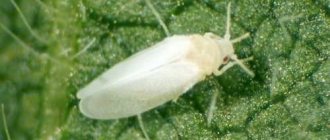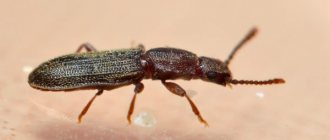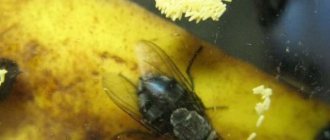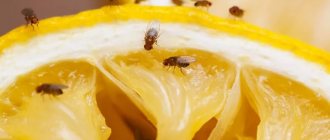This pest is very easy to notice, because white wings on green leaves can be seen from afar... This is what inexperienced gardeners think. In fact, the whitefly is a secretive and cunning enemy. Until the number of insects increases, whitefly individuals move exclusively along the underside of leaves, without revealing themselves in any way.
Sooner or later, the flower is shaken and then a white cloud consisting of tiny insects rises around it. It hangs in the air for a while, and then confidently heads towards a neighboring plant. The whitefly went on the attack...
Whitefly - everything you need to know
The whitefly is an insect from the aphid family. Causes serious damage to plants by sucking sap. It is not difficult to discover that the whitefly has settled on indoor plants (the photo will simplify the task) by itself and is actively laying eggs. To do this, just touch the infected crop - white small midges will surround it with a dense cloud.
Female whiteflies reproduce by laying eggs away from direct sunlight, preferably on the underside of leaves. The larvae cannot fly, so they spend most of their time motionless, gradually becoming covered with a white coating. Under the influence of the pest, parts of the plant change shape, lose color and fall off over time.
In addition, the insect is a carrier of infections.
The most vulnerable to whitefly are delicate indoor plants:
- roses;
- fuchsia;
- orchids;
- geraniums;
- primrose.
In indoor conditions, the insect is capable of infecting these plants throughout the year, flying from one to another around the apartment or house.
Whitefly at home - reasons for its appearance
To understand how to get rid of whiteflies on indoor flowers, you should study the characteristics of the pests and start with the reasons for their appearance in the house. Understanding what prompted them to settle on flowers will help prevent future infestations.
As a rule, the main reasons for the appearance of dangerous white midges in an apartment are:
- Failure to comply with temperature and humidity conditions.
- Inability to ventilate the room.
- High plant density.
- Infection through newly acquired plants.
High plant density provokes the appearance of pests.
The dangerous whitefly, paradoxically, is also very gentle. It dies if the temperature drops below 15 degrees, and its subsequent appearance becomes impossible.
General information about the pest
The size of the sucking insect is minimal - from 1 to 3 mm. The pest goes through a complex life cycle: on the affected plant it is possible to simultaneously identify not only adult individuals, but also tiny larvae and eggs. The hatched parasites are firmly attached to the leaves and actively drink the juices.
A characteristic feature of the insect is its white wings. The parasite resembles a scale insect in many ways. If you approach the plant, touch the leaves, or try to brush the pests off the bush, a white “fog” of pests appears in the air above the flower.
In the garden, closed ground, or apartment, certain types of whiteflies appear more often than others:
- citrus;
- tobacco;
- greenhouse
Ornamental plants at risk:
- myrtle;
- pomegranate;
- calla;
- fuchsia;
- geranium;
- fern;
- eucalyptus.
How to store a mink coat in the summer at home? Read useful information.
How to properly hang a horseshoe in your home to attract happiness and prosperity is written on this page.
Reasons for appearance:
- poor ventilation of rooms, stagnant air;
- excess humidity combined with elevated temperature;
- plants are planted close to each other;
- there is not enough space in the green corner for each specimen;
- poor care of indoor flowers.
The pest often appears in mini-greenhouses. The insect also easily enters the house through open windows. Sometimes owners bring whitefly eggs and larvae with soil from a nearby flower garden or with a donated/purchased plant on which the parasites have settled.
READ ALSO: Why pests of indoor plants appear: photos, how to deal with them and prevent re-infestation
Creating optimal conditions for pest control
When deciding to fight whitefly on indoor flowers, you need to be prepared for the fact that the process will not be quick and simple. Insects can be removed in several stages, observing certain conditions to prepare for the “war”.
They start with quarantine for infected plants. To prevent the spread of the insect, infected plants are separated from healthy ones and placed in a room with the lowest possible temperature.
If we are talking about flowers that are unpretentious to the cold, such as fuchsia, then the most suitable place for it would be a window sill on an open balcony in late autumn or early winter, when the temperature reaches the desired level. A week will be enough for the white butterflies to die completely.
After the mass extermination of the pest by temperatures, the remains of eggs and traces of adult individuals are washed off with water, and the soil in the pot is replaced with new one. Damaged parts of the plant are removed in order to prevent the formation of putrefactive cells.
Below are several ways to combat whiteflies if the freezing method is not suitable for some reason. For greater efficiency and taking into account the latest generation of larvae covered with a wax shell, several methods will need to be combined to achieve results.
Methods and means of controlling whitefly on indoor plants
There are several common ways to combat this insect.
Chemicals
In flower or garden stores you can find many chemicals to combat whiteflies. You can use drugs such as:
- Aktara is a long-acting drug. Protects plants for up to 5 weeks. This drug destroys not only moths, but also larvae. For the best effect, it is recommended to dilute the contents of the package into 2-3 liters. water and water the plants. The concentrated solution will not harm the plant, but will cope with the pest 100%;
- Confidor - after watering and spraying with this preparation, the whitefly begins to die within an hour. One treatment is enough. Prepare the solution according to the instructions;
- Admiral is one of the most effective remedies that affects the nervous system of the pest. Spray the plants with a solution in the proportion of 0.2-0.3 mg per 1 liter. water;
- Bankol is a contact-intestinal drug. Plants should be sprayed with a solution in a proportion of 0.5 g. drug per 1 liter. water;
- Actellik is an effective remedy against whiteflies and other insects. It is worth noting that this drug has a second degree of toxicity, as well as an unpleasant odor. 2 ampoules of Actellica are diluted in 2 liters. water. Spray the plants once;
- Spark – destroys the pest in one treatment. The drug exists in the form of tablets, powder or ampoules. Dilute according to instructions. You can both water and spray the plants;
- Akarin - affects the intestinal-digestive system of insects. This product should be sprayed directly onto the insects by spraying the plants. Dilute the drug according to the instructions.
Read also: When to harvest Isabella grapes for wine
Folk remedies
Folk remedies may be less effective, but safer for health.
Causes of whitefly:
Mechanical method
This method involves wiping the leaves of the plant by hand. In this case, special attention should be paid to the reverse side of the sheet. This can be done using cotton swabs, a soft cloth, or a kitchen sponge.
Temperature effect
Temperature changes are dangerous for adult whiteflies, as they cannot tolerate temperatures below +12 ̊C. You can move the plant to a cool room for a while. But if the insect has managed to lay eggs, then at the optimal temperature they can hatch.
Tobacco against whitefly
One of the simple and effective methods is tobacco infusion. To do this, take 20-30 grams of tobacco (the contents of a pack of cigarettes) and pour 1 liter. hot water. Leave in a dark place for 4-5 days. Spray the plants every 3-4 days.
We fight whitefly on fuchsia:
Dandelion infusion
To spray the plant, grind 50 grams of roots and 50 grams of fresh leaves and pour 1 liter. water. Leave for 1-2 days. Spray 1-2 times a week, after a week repeat the procedure again.
Soap solution
To prepare a soap solution, tar or laundry soap is suitable. Grind 30 grams of soap and dilute with warm water in a ratio of 1:6. The plant is sprayed with a solution or the undersides of the leaves are washed off with a sponge.
Garlic infusion
This infusion for spraying is made from 2-3 chopped garlic cloves per 1 liter. water. Leave for at least a day. After 2-3 treatments, take a week break.
How to deal with whitefly on Geranium:
Yarrow infusion
Pour 80-90 grams of yarrow herb into 1 liter. boiling water and leave for 1-2 days. Strain and spray the plants directly into the affected areas. Repeat the procedure 2-3 times with a break of 1 week.
Wood ash
Pests really do not like wood ash, which is often sprinkled on the soil under plants. A solution for spraying is also prepared on its basis. 100 grams of wood ash are diluted in 2.5 liters. water. Add soap solution if desired. The lower leaves of plants are sprayed or treated with this mixture.
Ammonia
To spray plants, prepare a solution of ammonia and water in a ratio of 1 tsp. for 3 l. water.
Traps
An excellent way to combat whiteflies is to use a trap. Such traps can be bought at any garden or flower shop or made yourself. Traps are a piece of yellow or orange paper or plastic with glue applied that does not dry out.
You can make such a trap with your own hands and at home. To do this, take thick cardboard or plywood and paint it yellow or orange, since whiteflies and other pests are attracted to bright yellow colors. Apply castor oil or a honey-rosin mixture or Vaseline to the painted cardboard. Such traps are installed above the crowns of plants.
Also, ordinary adhesive fly tapes, which are installed near plants, are used as traps for whiteflies and other pests.
Fumigator
The fumigator has proven itself well in the fight against whiteflies. This is an electrical device into which a plate or container containing a toxic liquid is inserted. When heated, toxic substances evaporate and pests die. To do this, you need to close the windows and doors and plug in the fumigator for 40-50 minutes.
People and animals should not be in the room, as toxic fumes can cause poisoning.
Physical impact on whiteflies - what does it come down to?
A proven remedy for whiteflies is mechanical traps. With their help, you can get rid of adult individuals capable of flying. You can make a trap with your own hands from scrap materials.
For a simple sample you will need small plywood sheets or sheets of cardboard. They must be painted in a color that attracts insects (white or yellow), lubricated with castor oil and a mixture of honey and rosin. Baits are placed near the insect habitat. For example, if they settled on fuchsia, then the bait is placed right there - on the windowsill.
As an option for a whitefly trap, simple fly tapes, fixed near the infected plants, are also suitable.
Chemicals against pests - which ones to choose?
If white midges on geraniums or fuchsias have proliferated so much that traps do not save the situation, it is worth moving on to more radical methods of control - using chemicals.
As mentioned above, a proven remedy against whiteflies is Aktara. It is used to treat the soil of plants infected with insects with accompanying spraying. You can increase the effectiveness of the drug by using it together with Actellik. Following the instructions, Actellik solution is used to spray indoor flowers.
A noticeable effect can be achieved by using Tanrek against the white pest. The result obtained in this case will last for at least three weeks, even at high temperatures.
Fitoverm has also proven itself well as a biological insecticide that is not capable of harming plants or humans. Along with it, benzyl benzoate emulsion, Fury, Mospilan, Intavir, Thiazipir and other drugs can be used.
For those who are going to use the drug Actellik or any of the above, the recommendation of adding shampoo or laundry soap to the solution may seem useful. In this case, the effect of the substances will be longer due to adhesion to the surface of the plants.
Geranium diseases
Let's find out how to identify this or that disease of pelargonium, and how to effectively treat it. Please note that many diseases occur due to improper care at home, and if maintenance errors are not corrected, their treatment will be useless.
Chlorosis
If the leaves of geraniums begin to change color, this often indicates chlorosis, that is, a failure in the process of photosynthesis due to a lack of mineral supplements. If the edges of the leaves become light, this is a nitrogen deficiency. A lack of sulfur manifests itself as a uniform yellowing of the entire plant, including the stems; magnesium - the appearance of spots between the veins of old leaves; iron - spots between the veins of young leaves. With phosphorus deficiency, a yellow spot forms on old leaves near the petiole, which then spreads to the entire leaf.
This disease can be cured by regular application of balanced complex fertilizers or a specific substance. For example, in case of iron deficiency, Antichlorosin (iron chelate) is added.
Dropsy
This is a physiological disease, the cause of which is not an infection, but improper living conditions, in particular overwatering, cold and high humidity. With dropsy, swollen, swollen areas appear on the underside of the leaves. To get rid of this disease, you need to properly care for the flower: reduce watering and spraying, and improve drainage if necessary. The room should be warm and well ventilated.
Read also Bengal breed of chickens description photo reviews
Bacterial burn
Dried areas appear on the leaves of pelargonium, they begin to curl and deform. Pelargonium stops developing.
Since it is useless to fight the emerging disease, cut off completely healthy areas for cuttings, and throw away or burn the diseased plant.
Ring spot
This disease is indicated by light ring-shaped spots on the leaves. Later, the infected leaf blades curl inward or droop like umbrellas.
Without treatment, the flower may die. To save it, pick and destroy any leaves that are curled or spotted, and treat the plant with fungicides.
Powdery mildew
Fungal infection. The main symptom is the appearance of a white powdery coating on the leaves.
Diseased geraniums should be treated with fungicides or colloidal sulfur, after picking off the infected leaves.
Blackleg
Also a fungal disease that attacks the stem: a dark spot appears at the soil level, then black rot grows rapidly until the stem breaks and the plant dies. The appearance of a black leg in geraniums is caused by too heavy soil, overwatering and poor drainage.
Cannot be treated. Cut off the top for rooting, the rest can be thrown away.
Late blight
If the leaves wither and curl, as if due to a lack of water, or dark, sunken spots appear on the leaves and stem, this is late blight. In a damp room, a white fluffy coating also appears on the stains. Most often, this disease is detected in late stages, when treatment is no longer possible.
If a small area is affected, remove it and replant the plant in new soil. For prevention and treatment, “Ridomil”, “Profit Gold”, “Previkur” are used.
Gray rot
Gray rot is identified by wet brown-gray spots on the stems and leaves of pelargonium. Rot often affects the plant due to excess nitrogen, stuffiness, too wet soil and air.
You can get rid of rot by cutting off the infected areas and treating the geranium with Fundazol. Vitaros is also used. When cutting, the cut sprout can be placed in a solution of one of these drugs to prevent rot.
Alternaria blight
Bubbles and spots with a whitish coating appear on the lower part of the leaf blade. The leaf gradually fades, turns yellow and finally falls off. The cause of the disease is most often excess moisture. We get rid of this problem by picking off diseased leaves and treating the geranium with Ridomil.
Rust
The first symptom is that light spots with dark red dots appear on the leaves. You can see a brown coating underneath.
If a small area is infected, it must be removed and the pelargonium should be treated with fungicides twice (with an interval of 2 weeks). Otherwise, save the healthy parts for cuttings and destroy the plant.
Verticillium wilt
The disease can occur when there is a lack of moisture and too high an air temperature. The main symptom is yellowed and wilted leaves and inflorescences.
After removing dry parts of the plant, increase the frequency of watering (avoiding overwatering). For prevention, you can use Trichodermin.
How to fight a pest using traditional methods?
Homemade decoctions and infusions also give a certain effect when you need to get rid of whiteflies on indoor plants. Compared to chemical drugs, such products are considered safer and more affordable. You can prepare the following types of drugs at home to fight with folk remedies:
- Tincture of yarrow herb (pour boiling water for a day, cool and use for spraying).
- Tincture of wormwood (dry herb is poured with boiling water for several hours, cooled and the plant is treated).
- A solution of laundry soap diluted in water for treating infected indoor flowers.
- A tincture of dandelion roots and leaves for spraying at intervals of several weeks.
- A tincture of dry citrus peels with a small addition of laundry soap.
- Garlic tincture for spraying.
All of the above remedies will help if white midges on fuchsia have not yet reached the scale where it is impossible to cope without chemicals.
Where do flower midges live and where do they come from?
Midges breed in flower pots under special conditions: if the soil is constantly moist and the air around is warm. Thus, by watering flowers too much, people themselves create conditions for the proliferation of insect pests. Midge eggs can remain in the ground for a long time and become active only under a combination of favorable conditions. In waterlogged soil, they “wake up” and hatch into larvae, which then transform into midges. And later, the adults will again lay eggs in the ground. And so it repeats in a circle.
Midges are a frequent visitor to a plant grower who waters his home greenhouse too often
Midge larvae can enter the soil in different ways:
- with ready-made, store-bought soil, if it contained eggs or larvae;
- with a new infected plant, purchased or donated (arrived, again, from the store);
- from the street, if midges flew onto the balcony in the summer and settled in a flower, and then safely moved with it to the window sill in the room;
- from the store, brought along with vegetables or fruits.
Adult insects will not harm the plant, but the larvae, feeding on the sap, can damage the root system and even cause the death of the flower. If midges appear in one of the pots, most likely the rest of the plants will become infected, so you will have to get rid of uninvited guests throughout the entire territory of the home greenhouse.
Three types of midges most often appear in flower pots:
- small with white wings - visible to the naked eye, they like to hide on the back of a leaf or jump along the surface of the ground. They prefer overwatered soil, harm plant roots and damage leaves. They are popularly called whiteflies (porudas, springtails);
- small black sciarid insects - their larvae are dangerous to the plant and, if actively reproduced, can destroy the root system of the flower. They do not harm a person, but cause irritation by impudently scurrying around the entire apartment and getting into food and drink;
- fruit flies (drosophila) - the larvae eat the root system of the flower, and the adults instantly settle in all possible hot spots. In addition to overflowing flowers, they love vegetables and fruits that are not stored in the refrigerator.
Midges are not dangerous to humans, but if you do not get rid of the insects, they can reproduce all year round.
Photo gallery: insects that most often live on indoor plants
The whitefly is visible to the naked eye: it moves along the soil or hides on the underside of leaves
Small black sciarid midges breed in indoor flowers
Drosophila is a very small midge that can live in indoor flowers or among fruits and vegetables
Biological methods - what are they?
If actara (you can read how to plant on the packaging) seems too risky, it’s worth trying a biological effect that is more friendly to plant health. For domestic plants, this method of control will be justified only if the flowers are grown in large quantities.
We are talking about the resettlement of a small rider. It is called encarsia and is released into crops at the beginning of the breeding season of the whitefly pest.
This is a predator that pierces the pest larva in order to suck out the lymph and gain vitality.
Packages of ready-made encarsia eggs can be easily purchased at specialized sales points. It is worth remembering that the predator attacks only the greenhouse whitefly and is powerless against tobacco and citrus fruits.
Another natural remedy for pests is the spores of the fungus Verticillium. Applying it to the plant will eliminate insects in a short time.











